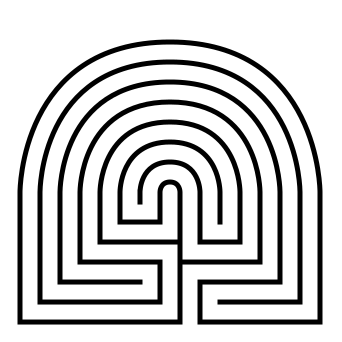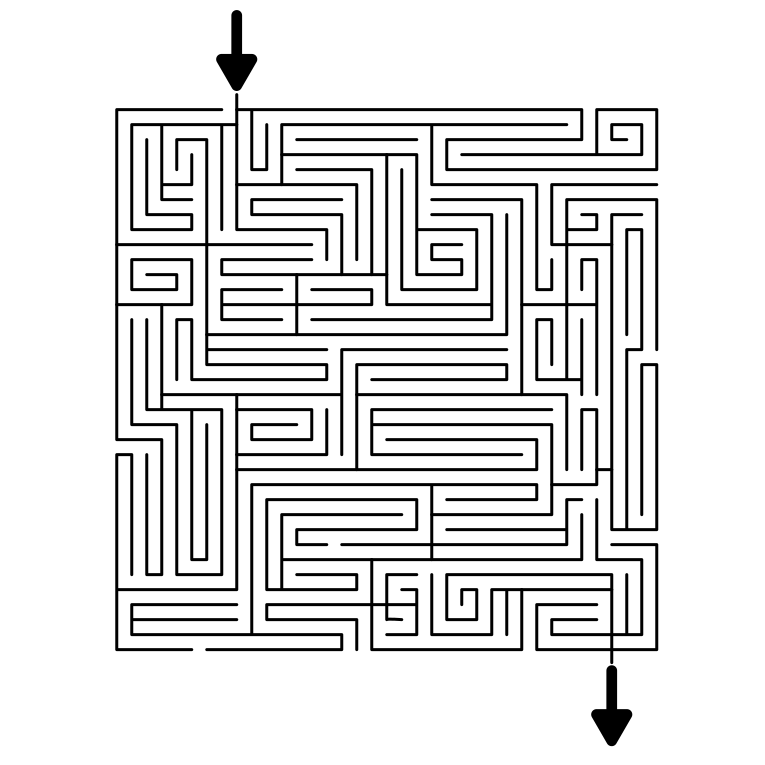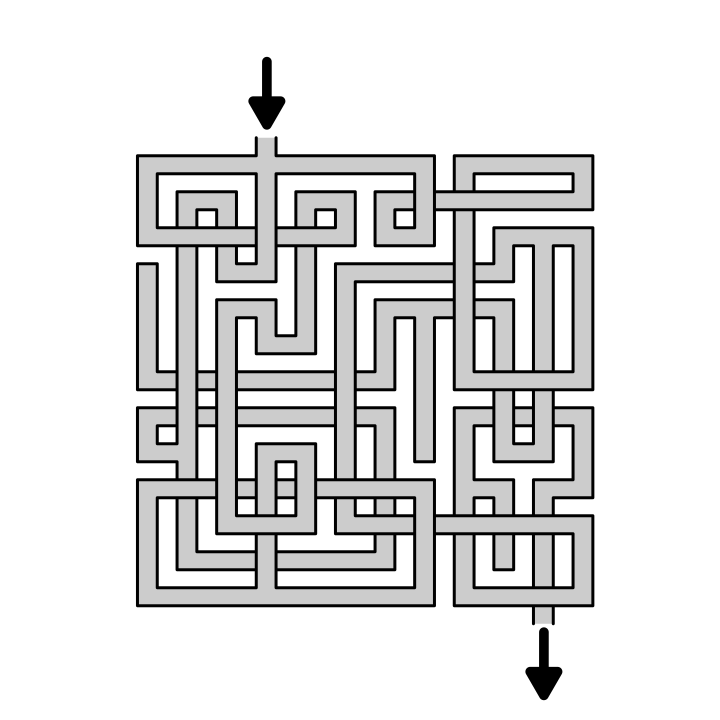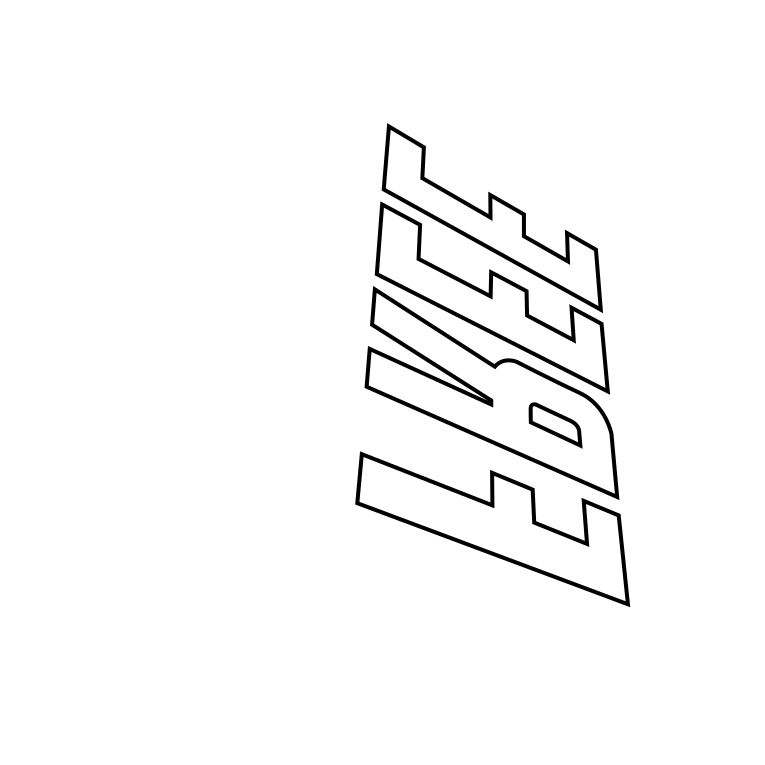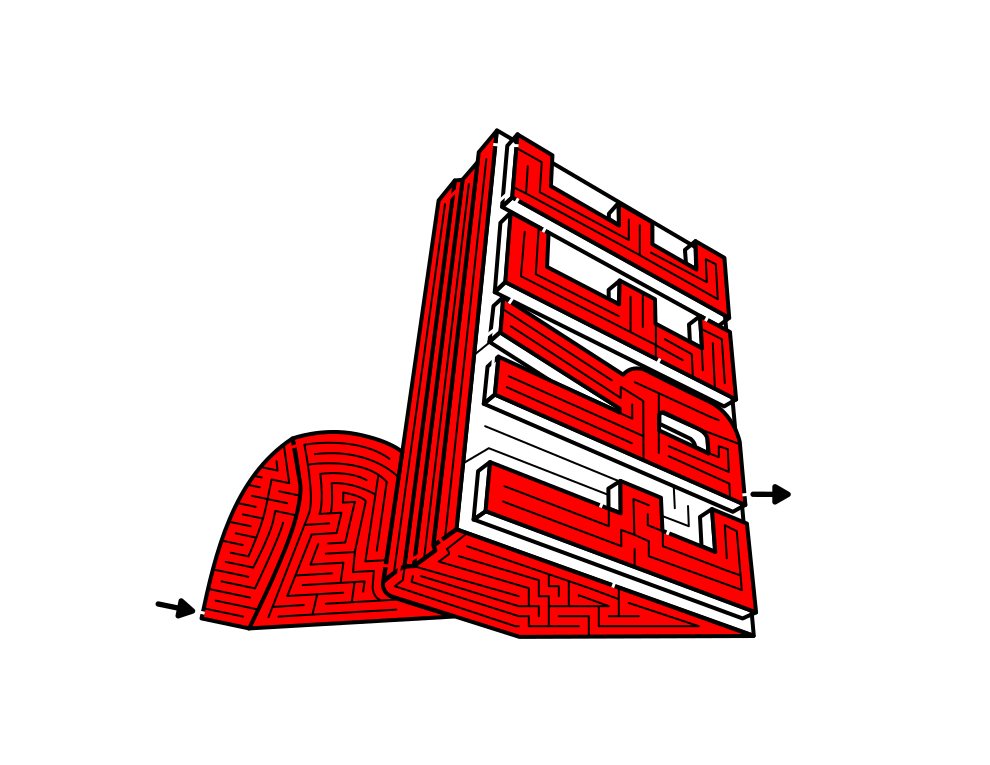There are many types of mazes and labyrinths, with construction materials and pathway design being the main differentiators between them. Below are 44 of the most popular types of mazes and labyrinths you might find, with some really interesting maze types mixed in you rarely see. This includes both mazes in the physical world and those that are created by puzzlers for solving.
Area Mazes - Called a maze, but actually a type of logic puzzle from Japan created by Naoki Inaba. Used to teach Japan children mathematics and logic. Solving requires calculating the area of a rectangle, often multiple times. Also called Menseki Meiro. If you would like to try to solve some, online area maze can be found here.
In the below example you would first solve the wall under the # 12. You solve the equation 4 * Y = 12. So Y = 3, meaning the bottom left side of the square has a length of 3. Now you can solve using the 3 and the 21 to calculate the length of the left side of the square above the 4. Solve 3 * Y = 21. The answer is 7. Continue this to solve the Area Maze.
Area Maze
Arrow Mazes - Mazes where movement is determined by the direction of the arrows. One version includes mazes where you move from arrow to arrow with directional choices that are limited to a few intersections. Another version is where pathways contain arrows that can only be traveled on in the direction the arrow points. Here is an example of each different version: For the example on the left once you move from START you follow the pathway until a choice needs to be made. On the example on the right you cannot be a salmon and go down a pathway against the arrows.
If you are interested in How to Make an Arrow Maze, including a video of one being made, additional Arrow Maze examples, or Arrow Maze Books, I have that covered.
Arrow Maze version 2 - Cannot take paths against an arrow
And here is an example of a third version which I call a Slide Arrow Maze. It is much more difficult. Landing on a slide arrow allows you to move to ANY arrow in the direction the one you are on is pointing ! Start from the red arrow and try to reach the goal. How to Make a Slide Arrow Maze step by step instructions.
Baltic Wheel Labyrinth - A labyrinth with two entrance/exits based off of a y shaped start. One of the paths leads quickly to the center which also has two entrances/exits.
Baltic Wheel Labyrinth
Blind Mazes (and assorted similar names) - A maze almost exclusively found in an online game where you cannot see the maze as you are solving it (or a very small fraction) because it is blacked out. Essentially you are solving the maze blindly and knowing where to go based on hitting/not hitting the walls. Playable examples include Maze Shadow, and Maze Shadow 2. And yes, this is an odd example, but accurate:
Blind Maze
Block Maze - Also known as a Block Move Maze, a maze solved by adding a determined number of blocks to create a pathway to the goal, or by moving (shifting) a determined number of blocks. I have a free downloadable 13 page booklet in my book section, and also step by step instructions on How To Make a Block Move Maze.
Block Maze
Caerdroia Labyrinth - A type of Welsh turf maze based on the Cretan labyrinth design. In the center was usually a small hill, called a twmpath used to dancing and playing music.
Caerdroia Labyrinth
Chakravyuha Labyrinth - A type of labyrinth design from India whose center ends with a spiral.
Chakravyuha Labyrinth
Chess Mazes - A maze made by placing chess pieces on a chess board for 1 of 2 possible things: 1 - most commonly to train players how to visualize and develop move sets to become a better chess player, or 2 - as a less serious puzzle to be solved like a more traditional maze. Link to the top selling book by chess writer Bruce Albertson by clicking the book cover below.
Classical Labyrinths - Labyrinths in this pattern feature a cross, a right angle and a dot in each quadrant to build the construction. Can be represented by 3, 7, 11 or 15 circuit versions. Learn how to draw a digital 7 circuit and many other types of labyrinths. Commonly used as a spiritual tool that is walked through in the physical world.
Classical Labyrinth
Color Mazes - Mazes where the paths that can be taken are determined by a specific order of colors. i.e. moving from red to white to blue, or by alternating colors at each junction. A type of conditional maze (definition is next below). Want to learn How to Make One ?
Conditional Mazes (also called logic mazes) - Mazes where movement is determined by a pre-determined pattern or rule (conditions) that must be followed in order to move in the maze. Includes math mazes, number mazes, arrow mazes, directional mazes, and color mazes.
Corn Mazes (Known as Maize Mazes in England) - Mazes whose walls are made of full grown corn stalks. Made by cutting pathways into an existing field. Sometimes corn mazes are actually made of the grain sorghum which grows similarly to corn. Best viewed from above !!
Meckley’s Flavor Fruit Farm, Somerset Center, United States, photo by Chris Bair
Cretan Labyrinth - Another name for a 7 circuit classical labyrinth.
Drawing Mazes - Mazes done for fun from a website like this one, or from a maze or activity book (as opposed to physical mazes like a corn maze or hedge maze). Can be hand drawn or digitally drawn. They are meant to be solved as a challenge for the solver. Learn how to draw over 40 different types of drawing mazes.
Dynamic Mazes - (also called Sliding Door mazes) - A maze type where the maze changes as you solve it. Typically this means passing over trips/switches which open and close other pathways in the maze. You can play a set of 12 different dynamic mazes designed by Jorge H Best.
Courtesy: https://dynamicmazes.webs.com/DynamicMazes.html
Eyeball Mazes - A type of puzzle maze designed to be solved using your eyes (so no writing utensil is needed !) You can attempt 12 different versions at logicmazes.com developed by Robert Abbott. Note that to solve them JavaScript must be enabled in your web browser. Below is an example from the site. Starting at the bottom circle with eyes, you may only move to another square with the same color or same shape that you are on.
Hay Bale Mazes - Mazes made of stacked hay bales. It makes me feel itchy just thinking about it ! But it also looks like a great deal of fun for kids ! Watch a video showing an example here.
Hidden Picture / message maze - A drawn maze whose solution spells out a word or draws a picture in the maze. A well designed hidden maze does not show the solver the message until it is completed. Takes some practice, but you can learn how to make them ! A second type of hidden message maze is a Hidden Message Trail Maze which uses letters to spell out words instead of pathways. My example is a quote by Wilt Chamberlain.
This hidden message trail maze quote also contains a hint below it that gives you the length of each word.
Labyrinths - A pathway that does not include any junctions or choices. Reaching the destination only takes a commitment to finish. I have a whole section dedicated to making these.
Laser Mazes - Obstacle courses made of lasers where the object is to go from the start to a goal without a laser beam touching you. Sometimes these challenges are timed to compete against other solvers/friends. Think Catherine Zeta-Jones in the 1999 movie Entrapment. Check out this video of a laser maze from the Heide Park Resort. There is also a written puzzle called a laser maze where you act as if the movement through the maze is a laser bouncing off of a wall/mirror:
Directional Mazes - Left Turn Mazes (No Right Turn Mazes) (and vice versa) - A type of conditional maze that must be solved without taking the type of turn specified by the maze creator. Below is a left turn maze, or alternatively a NO right turn maze. Learn how to make a directional maze.
Light Mazes - A maze created using lights to make either the pathways or the border of the maze. Example pictured: Loucen Maze in Loucen, Czechia designed by Adrian Fisher Design.
Phot0 from Adrian Fisher Design
On Line Maze - The below maze is also an example of a drawn maze that is solved by traveling on the line instead of between them (as in a typical drawn maze pathway). The above Directional Maze is also an on line maze, as is the regular example below that does not prohibit any turns.
Line Leads Mazes - A maze (a set of labyrinths actually) where you need to determine which of many possible lines leads to a destination. The lines do not include any junctions or choices and are a continuous path that cross around each other to confuse the solver. They are probably the easiest type of maze to make, but if you need help.
Logic Mazes (also called Conditional mazes) - Mazes where movement is determined by a pre-determined pattern or rule that must be followed in order to move in the maze. Includes math mazes, number mazes, arrow mazes, and color mazes.
Man in the Maze Labyrinth - Created by the Tohono O’Odham or Papago Indians of the Central Valley in Arizona in the United States. Used as a symbol for the tribe that can convey a variety of meanings depending on the family, usually dealing with the paths one takes in life.
Man in the Maze labyrinth
Math Mazes - A maze where the path taken next is determined by solving a math problem and moving in the direction of the correct answer. Perfect to keep students engaged and actually a maze that needs some strategy to create a good one. Also unique because it is a maze where it is possible for a solver to incorrectly reach the goal, but that is why teachers grade papers. I also have a section of pre made math maze templates.
Meandering Labyrinth - A labyrinth whose path follows the classical Greek key pattern. For some this can also describe a pathway that literally meanders in a seemingly random pattern. Think of a pathway than runs around a public park. Version 2 below:
Mirror Mazes - Mazes where the walls are made of mirrors to confuse the solver and disorient their direction while they attempt to solve the maze. Often found in fun-houses. Also a plot device in many horror movies. You can have fun watching videos on YouTube showing these, like this one.
Mosaic Mazes (and labyrinths) - most commonly found in churches in Italy and France and often done as a labyrinth. It is believed that the labyrinth helped ward off evil spirits and so you would typically find this mosaic artwork at an entrance. Below is a drawing of a mosaic labyrinth.
Number Mazes (also known as a Counting Maze) - Mazes where moving thru them is determined by a pre-determined numerical pattern. i.e. counting by 2’s, using only odd numbers, counting by 7’s. A type of conditional maze that is fun to make. Make a great addition to children’s activity books.
Painted Mazes - Exactly what it sounds like. Mazes created on canvas, paper, pavement, or stone using paint. Of course this can also be a painted labyrinth.
Panel Mazes - Mazes where the barriers are made by panels, often made of wood, but can be of other materials like plastic. The panel design allows the walls to be transported and moved between locations and also allow the maze pathways to be changed periodically to encourage repeat but new experiences. These mazes were popular in Japan in the 1980’s. Check out this wonderful video showing a panel maze:
Paving Stone Mazes - A Maze designed with paving stones or bricks for paths. Can be stone only or be mixed with turf/earth to create boundaries. If made with stones only different colors of stones are used to represent paths vs. walls. A company that specializes in this type of maze is The Labyrinth Company.
Picture Maze - A drawn maze that looks like a scene/picture but actually contains a maze to complete within the picture. Sometimes considered “Maze Art”. Here is my picture maze of the Playhouse Square sign in Cleveland, Ohio. The full larger version (with free download) is available on this site !
Puzzle Maze - A type of logic maze where the solver must use a key to determine the direction you can move within the maze. Part puzzle, part maze. Learn how to make a puzzle maze. The below example has simple movements, but they can be much more complex.
Sand Mazes/Labyrinths - Temporary mazes/labyrinths drawn in the sand, typically on the beach for recreation and spiritual practice. Most commonly these are labyrinths used for meditation walking.
Santa Rosa Labyrinth - A labyrinth design by Lea Goode-Harris that consists of 8 concentric circles. You can learn more about it’s creation.
Stone Labyrinths - Formed by the careful placement of large stones in a labyrinth pattern. Over 300 stone labyrinths exist in Sweden where they are most common, with a few more scattered in nearby Scandinavian countries.
Tilted Maze - A type of conditional maze where you imagine yourself tilting the maze (pretend you are a marble inside the maze), and then moving in the direction chosen until you reach a wall. Each tilt takes you to a new wall until you reach the exit.
Tilted Ball Mazes - A physical maze typically hand held that is solved by tilting the maze to maneuver a small ball or marble from the start to a goal. A classic game that makes a wonderful gift for a maze lover ! You can watch a tilted ball maze video here as an example.
Turf Mazes - Historically mazes (despite the name these are almost always labyrinths !) made of earthen mounds that were common in England and Wales, though few remain today. Can also be temporary and cut into a lawn with a lawnmower.
Water Mazes - A type of maze used by scientists to test rodents, which are timed during their swim in the water. The 2 main types of Water mazes are the Cincinnati Water Maze (used to measure how fast the subject escapes the maze) and the Morris Water Maze ( Wikipedia: “It is widely used in behavioral neuroscience to study spatial learning and memory.). The CWM is considered superior by many because you can count the numbers of mistakes the rodent makes over time.
Weaving Mazes - Mazes that have paths that go over /under each other in a weaving like pattern, giving a maze drawn on a piece of paper another dimension to work with. I like making these mazes so much I published a book of them, have written about How to Make a Weaving Maze and have a few more examples on the site. Some versions of this maze also include mini arrows at the under/over intersections (but generally I do not think they are needed). Another version of this is the Pipe Maze which themes the pathways !








